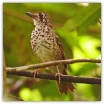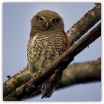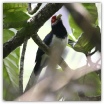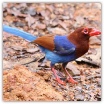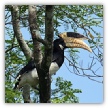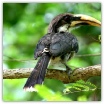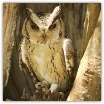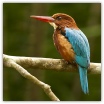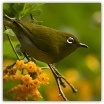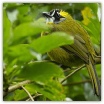
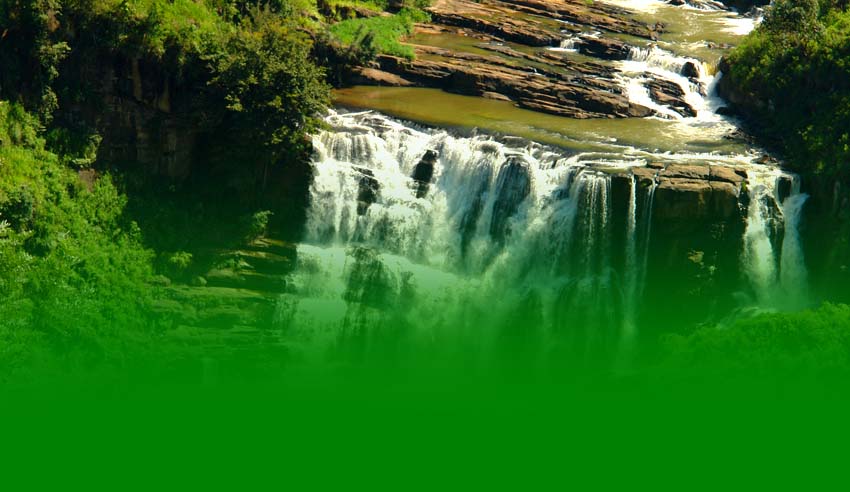
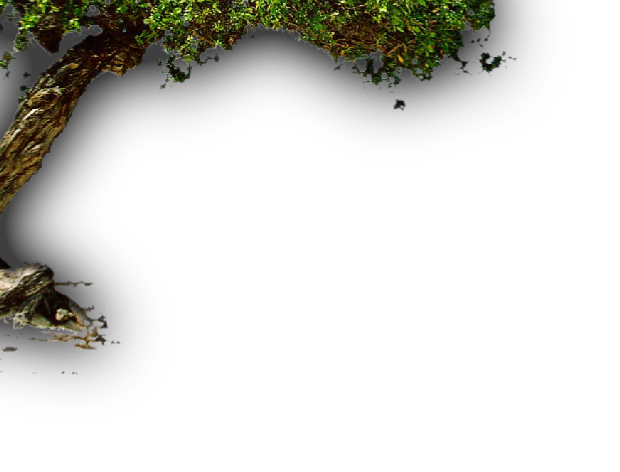




ENDEMIC BIRDS

A rare ground dwelling species is present in the dense forests of the southern part of the island. Essentially a forest bird that can be found infrequently...



 Sri Lanka Facts
Sri Lanka Facts




Day 01. Arrival and transfer to Kitulgala.
The Kelani Valley Forest Reserve across the river in Kitulgala had been established to preserve a part of the watershed of the Kelani River. Kitulgala which is also famous as it was the location for the 1957 David Lean movie ‘The Bridge on the River Kwai’ is home to many of Sri Lanka's lowland endemic bird species.
After some rest, spend the afternoon birding around the Kitulgala village.
Species to look for are Ceylon Green-pigeon, Ceylon Hanging-parrot, Layard's Parakeet, Green-billed Coucal, Serendib Scops-owl, Chestnut-backed Owlet, Ceylon Frogmouth, Ceylon Grey Hornbill, Yellow-fronted Barbet, Black-capped Bulbul, Spot-winged Ground-thrush, Ceylon Rufous Babbler, Legge's Flowerpecker and Black-throated Munia.
Lunch, dinner & overnight saty at a hotel/guest house in Kitulgala.
_____________________________________________________
Day 02. Kitulgala.
Spend the full day birding in Kelani Valley Forest Reserve and the Kitulgala village.
Lunch, dinner & overnight stay at a hotel/guest house in Kitulgala.
_____________________________________________________
Day 03. Kitulgala – Sinharaja.
After breakfast, spend a couple of hours birding in the area and leave for Sinharaja Rainforest driving via Ratnapura, the City of Gems.
Spend the afternoon bird watching around the lodge which is located in the Kudawa village adjacent to the rainforest.
Species to lookout for: Ceylon Green-pigeon, Ceylon Hanging-parrot, Layard's Parakeet, Yellow-fronted Barbet, Black-capped Bulbul and Ceylon Rufous Babbler.
Dinner & overnight stay at a lodge near Sinharaja.
_____________________________________________________
Day 04. Sinharaja.
Full day birding in Sinharaja Rainforest with picnic lunch.
Sinharaja is Sri Lanka’s last remaining rainforest (A UNESCO World Heritage Wilderness Area) which is famous for Sri Lanka’s lowland endemic birds and mixed species flocks which according to a study carried out over many years, have an average of over 40 individual birds. This number makes this one of the world's largest mixed species bird flocks if not the largest.
Birding highlights include Ceylon Spurfowl, Red-faced Malkoha, Serendib Scops-owl, Chestnut-backed Owlet, Ceylon Frogmouth, Malabar Trogon, Spot-winged Ground-thrush, Ceylon Scaly Thrush, Ashy-headed Laughingthrush, Ceylon Scimitar-babbler, Ceylon Rufous Babbler, Legge's Flowerpecker, White-faced Starling, Ceylon Hill-myna, Black-throated Munia, Ceylon Crested Drongo and Ceylon Blue Magpie
Dinner & overnight stay at a lodge near Sinharaja.
_____________________________________________________
Day 05. Sinharaja.
Full day birding at Sinharaja Rainforest with picnic lunch.
Dinner & overnight stay at a lodge near Sinharaja.
_____________________________________________________
Day 06. Sinharaja – Udawalawe/Embilipitiya.
After breakfast, spend a couple of hours birding in the area and leave for Udawalawe or Embilipitiya to do an afternoon Jeep Safari in the Udawalawe National Park.
Udawalawe is a very popular national park for its Elephants and birds. The park is a mixture of abandoned Teak plantations, grassland, scrub forest and some riparian forest along the rivers ‘Walawe’ and ‘Mau Ara’. Udawalawe is probably the best place to see wild herds of Elephants in tightly-knit family groups of up to two or three generations.
Key species of birds to look for in the park are Spot-billed Pelican, Lesser Adjutant, White-bellied Sea-eagle, Grey-headed Fish-eagle, Crested Hawk-eagle, Barred Buttonquail, Orange-breasted Green-pigeon, Sirkeer Malkoha, Blue-faced Malkoha, Malabar Pied Hornbill, Blyth's Pipit and Ceylon Woodshrike.
Possible Mammals: Toque Monkey, Hanuman Langur, Golden Jackal, Ruddy Mongoose, Asian Elephant, Spotted Deer, Water Buffalo, Sri Lankan Giant Squirrel and Indian Hare.
Dinner & overnight stay at a hotel in Udawalawe or Embilipitiya.
_____________________________________________________
Day 07. Udawalawe/Embilipitiya – Tissamaharama.
Leave after an early breakfast for a second jeep safari in Udawalawe National Park and proceed to Tissamaharama after the safari.
Spend the afternoon birding around the wetlands of Tissa.
Possible species around Tissa wetlands: Spot-billed Pelican, Yellow Bittern, Chestnut Bittern, Black Bittern, Cotton Teal, Watercock, Purple Swamphen, Pheasant-tailed Jacana, Pied Crested Cuckoo, Brown Fish-owl, Stork-billed Kingfisher, White-naped Flameback, Indian Reed-warbler, Streaked and Baya Weaver.
Dinner & overnight stay at a hotel in Tissa.
_____________________________________________________
Day 08. Tissa.
Early start with picnic breakfast for a morning jeep safari in Yala National Park
Yala is indisputably Sri Lanka's most visited National Park and the best in the island for observing a wide variety of animals, the main attractions being Sri Lanka Leopard (endemic sub-species) and Sloth Bear.
Key bird species to look for: Black-necked Stork, Ceylon Junglefowl, Barred Buttonquail, Great Thick-knee, Small Pratincole, Jerdon’s Nightjar, Indian Little Nightjar and Brahminy Starling.
Possible Mammals: Golden Jackal, Sloth Bear, Ruddy Mongoose, Stripe-necked Mongoose, Leopard, Asian Elephant, Wild Boar, Sambar, Spotted Deer, Water Buffalo, Sri Lankan Giant Squirrel and Indian Hare.
Lunch at the hotel and do another jeep safari in Yala National Park.
Dinner & overnight stay at a hotel in Tissa.
_____________________________________________________
Day 09. Tissa - Nuwara Eliya.
Leave early for a morning jeep safari in Bundala National Park with picnic breakfast.
Bundala National Park Sri Lanka’s first Ramsar Site is an internationally important wintering ground for migratory water birds. Bundala harbors over 190 species of birds including the Greater Flamingo, which migrate in large flocks.
Possible noteworthy species: Watercock, Whimbrel, Eurasian Curlew, Curlew Sandpiper, Little Stint, Black-winged Stilt, Red-necked Phalarope, Small Pratincole, Brown-headed Gull, Gull-billed, Caspian, Lesser Crested, Great Crested, Sandwich, Common, Little, Saunders's, Whiskered and White-winged Tern.
After the park proceed to Nuwara Eliya with a lunch stop en route.
In the afternoon visit the Victoria Park for Himalayan migrants Kashmir Flycatcher, Pied Thrush, Indian Pitta and Indian Blue Robin. Other highlights include Yellow-eared Bulbul, Sri Lanka White-eye and Dusky Blue Flycatcher.
Dinner & overnight stay at a hotel in Nuwara Eliya.
_____________________________________________________
Day 10. Nuwara Eliya.
A pre dawn start to reach Horton Plains National Park at first light (with picnic breakfast) to look for the highland specialities.
Horton Plains National Park is a protected area in the central highlands of Sri Lanka and is covered by montane grassland and cloud forest. This plateau at an altitude of 2,100–2,300 meters (6,900–7,500 ft) is rich in biodiversity and many species found here are endemic to the region. The Horton Plains are the headwaters of three major Sri Lankan rivers, the Mahaweli, Kelani and Walawe. The plains' vegetation is grasslands interspersed with montane forest.
Species to lookout for: Ceylon Woodpigeon, Yellow-eared Bulbul, Common Blackbird, Ceylon Whistling-thrush, Kashmir Flycatcher, Dusky Blue Flycatcher and Sri Lanka Bush-warbler.
Possible Mammals: Purple-faced Leaf Monkey, Sambar and Dusky Striped Squirrel.
Return to Nuwara Eliya for lunch and spend the afternoon birding around Nuwara Eliya.
Dinner & overnight stay at a hotel in Nuwara Eliya.
_____________________________________________________
Day 11. Nuwara Eliya – Kandy.
Leave after an early breakfast for a last opportunity for birding around Nuwara Eliya and proceed to Kandy visiting a Tea Factory en route.
After lunch at the hotel visit the Royal Botanical Gardens in Peradeniya
Species to lookout for: Ceylon Hanging-parrot, Alexandrine Parakeet, Layard's Parakeet, Common Hawk-cuckoo, Ceylon Small Barbet, Forest Wagtail, Tickell's Blue Flycatcher, Indian Pitta and Common Hill-myna.
Dinner & overnight stay at a hotel in Kandy.
_____________________________________________________
Day 12. Kandy – Habarana.
After an early breakfast visit Udawatta Kele Sanctuary for a few hours’ birding.
Udawatta Kele Sanctuary, often spelled as Udawattakele, is a historic forest in the city of Kandy situated behind the famous Temple of the Tooth Relic ‘Dalada Maligawa’. The extent of this forest is about 257 acres and the vegetation is mostly plantation and secondary formations. This harbors a number of endemic bird species inside a total of over 80 species.
Species to lookout for: Emerald Dove, Ceylon Hanging-parrot, Layard's Parakeet, Yellow-fronted Barbet, Ceylon Small Barbet, Crimson-backed Flameback, Tickell's Blue Flycatcher, Indian Blue Robin, White-rumped Shama, Brown-capped Babbler and Common Hill-myna,
Descending from the central hills in the northern direction we travel to Habarana in the Dry Zone. After lunch at the Lodge, birding in the garden and around the Habarana Tank where over 130 species have been recorded.
Species to lookout for: Spot-billed Pelican, Oriental Darter, Cotton Teal, Yellow Bittern, Black Bittern, White-bellied Sea-eagle, Grey-headed Fish-eagle, Watercock, Brown Fish-owl, Jerdon’s Nightjar, Malabar Pied Hornbill, Indian Pitta, Large Cuckooshrike, Black-headed Cuckooshrike, Pied Flycatcher-shrike, Ceylon Woodshrike, Asian Paradise Flycatcher and Thick-billed Flowerpecker,
Dinner & overnight stay at a lodge/hotel in Habarana.
_____________________________________________________
Day 13. Habarana.
After an early breakfast visit Sigiriya Sanctuary for a half day’s birding.
Sigiriya is incredible not only because it is one of Sri Lanka’s most fascinating cultural heritage sites, it is also one of the islands best birding locations! Birding around the Sigiriya Rock and the surrounding forest before climbing the rock fortress would yield some good dry zone species.
Species to lookout for: SHAHEEN (LOCAL RACE OF THE PEREGRINE), Pied Crested Cuckoo, Blue-faced Malkoha, Grey-bellied Cuckoo, ‘Square-tailed’ Drongo-cuckoo, Indian Cuckoo, Crested Treeswift, Ceylon Grey Hornbill, Malabar Pied Hornbill, Indian Pygmy Woodpecker, Rufous Woodpecker, Indian Pitta, Large Cuckooshrike, Black-headed Cuckooshrike, Small Minivet, Orange Minivet, Pied Flycatcher-shrike, Ceylon Woodshrike, Asian Paradise Flycatcher, Orange-headed Thrush, Thick-billed Flowerpecker, Ashy Drongo and Greater Racket-tailed Drongo.
The afternoon is at leisure to relax at the hotel or take in some relaxed birding at your own pace.
Dinner & overnight stay at a lodge/hotel in Habarana.
_____________________________________________________
Day 14. Habarana – Airport.
Spend the morning exploring the area for the last time before having lunch at the lodge.
After lunch transfer to a hotel in Katunayaka for dinner and transfer to Airport for departure.
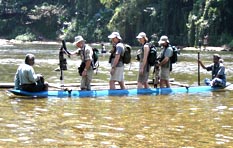
Kitulgala
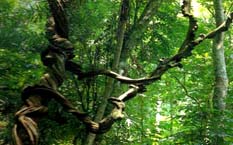
Sinharaja
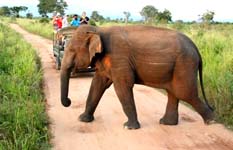
Udawalawe
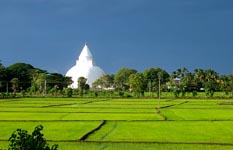
Tissamaharama
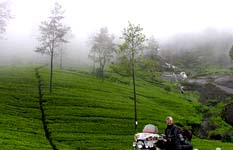
Nuwara Eliya
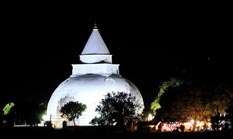
Tissa
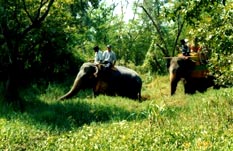
Habarana

Habarana
